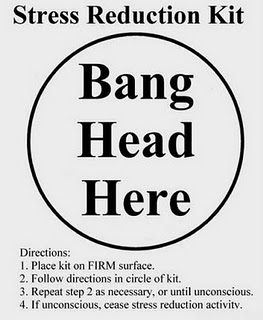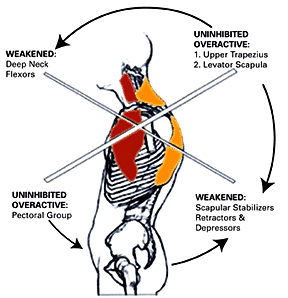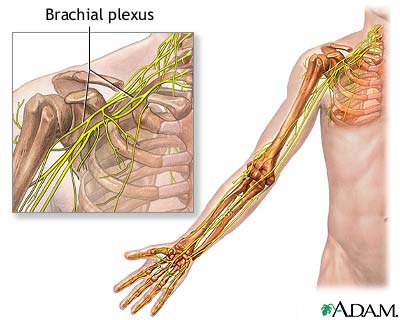Top Five Reasons Overhead Pressing Sucks
I had a member come up and ask me a question the other day about his sore shoulder. He said it was a dull ache in the front of the shoulder that was worse when he tried to raise his arms up in the front and to the sides, and it caused some noticeable discomfort when he did any type of pressing, especially overhead pressing, which he found time to work into each and every workout. (NOTE: As much as I want to swear at people like this, I try to remain somewhat professional and help a brotha out). I asked him how long he had been dealing with this, and his response kind of floored me.
Oh, on and off for about a year or two.
Now despite the fact that I was more shocked than when I heard Scottie Pippen say LeBron was a better player than Jordan (REALLY Scottie? You’re gonna give up your own teammate? And why is a 50-year-old man still going by “Scottie”?), let’s review the bullet points here:
1. Pain with pressing
2. Pain for the past year (or two??)
3. Keeps on pressing, even though it hurts
Excuse me while I bang my head into the wall here for just a few minutes.
Now the kicker was that after pretty much telling me he was too oblivious to notice a pattern here with the pressing and his pain, he didn’t want me to tell him ways to fix his shoulder. No no, he wanted ways that he could continue to overhead press, because it was part of his program. Every day. Which hadn’t changed for over ten years. Face, meet palm.
So after spending the better part of ten minutes trying to explain to a very literate and articulate guy who was obviously smart enough to hold a conversation on why overhead pressing was probably causing the problem, and that he would be better off getting a new program to address the fact, we both came to the conclusion that he wouldn’t change what he was doing, even though it was causing him pain and probably would result in a rotator cuff tear, or worse. At that point, I’ll have to start training him to fix the damn thing, and chage him a butt-load of money in the process. But hey, a ten minute freebie wasn’t worth it, I guess.
Now why do you think the overhead pressing was one of the things that would be causing his shoulder pain? Well, we’re going to look some of the facts that makes overhead pressing one of the lowest reward and highest risk exercises in the book.
1. Altered Spinal Mechanics
Let’s face facts, most people tend to have a degree of kyphosis in their spines from all their time hunched over a computer or at a desk. Why, I’ll bet you’re hunching your ass over just reading this text. See that?? You just sat up didn’t you??!!? HAHAHAHAHA!!!
Sorry. Had to have a little fun here.
Kyphosis is when you’re slumped over, your shoulders are hanging forward, and your head is in an anterior position. Essentially, the geeky dude in the computer lab, or Mr. Burns from the Simpsons. Vladomir Janda coined the term “Upper Cross Syndrome” to describe the concept of how this posture has positions of stiffness and tightness. Specifically, the upper trapezius is short and tight and coupled with a short and tight pec minor, and the lower traps and scalenes are stretched and weak.
Now the reason kyphosis is important to the overhead pressing is simply that the scapula is forced to protract when the spine is in kyphosis, which means its ability to rotate upwards is limited. This limitation will cause the reduction in overhead range of motion, meaning the humerus has a greater chance of rubbing the hell out of the supraspinatus tendon, meaning rotator cuff pathology, baby!! Top it off with the fact that the structures along the cervical spine are under more tension than normal, and now we’re hanging a weight off them from an unbalanced position and we’ve got some additional neck trauma to go with your awesome sauce.
So since most people have some difficulty with spinal mechanics through kyphosis, having them do overhead pressing is like building a house on a shaky foundation: that shit’s gonna come down, and it’s gonna make a big mess when it does. As such, most people shouldn’t be able to do overhead pressing unless they can perform a full range of motion T-spine extension using a foam roller or other mode. Barring that, one of my favorite ways of showing people how much they fail at life by means of their abilities to get T-spine mobility is the lateral lunge and overhead driver.
2. Dysfunctional Scapular Mechanics
To perform an overhead press, the scapula has to tilt and rotate on the spine in order to provide enough clearance for the humerus to move overhead without banging it into the acromion process of the scapula and ripping the hell out of the supraspinatus tendon.
As mentioned before, the weakness of the lower traps and dominance of the upper traps, as well as the dysfunction of the serratus and pec minor impair the ability of the scapula to rotate properly. Combine this with the fact that most people possess the scapular retraction strength of a wet chihuahua and you have an overhead pressing recipe for disaster. If you’re one of the many people with stiff and immobile scapulae, give some of these little beauties a go.
3. Humeral Positioning is Altered
The shoulder has been described as a “ball and cup” joint, because the socket is pretty shallow, and the humerus can move around in it all crazy-like. Most of the time it tries to stay centered in the socket as much as possible, but every now and then you find a shoulder where the humerus is gravitating towards the front (anteversion), the back (retroversion), the top (elevation) or the bottom (depression) of the socket, which means the mechanics are going to be less than optimal.
 Now let’s say you fall into the category of the desk jockey Mr. Burns type, who tend to have their shoulders in a bit more anteversion than optimal. This means the rotator cuff is held stretched out and weak, and it’s ability to generate force to pull the humerus into the socket in order to give it a good base of support is going to be limited, which also means that as you press up, the humerus has more of a tendency to travel vertically and beat the holy hell out of the supraspinatus tendon.
Now let’s say you fall into the category of the desk jockey Mr. Burns type, who tend to have their shoulders in a bit more anteversion than optimal. This means the rotator cuff is held stretched out and weak, and it’s ability to generate force to pull the humerus into the socket in order to give it a good base of support is going to be limited, which also means that as you press up, the humerus has more of a tendency to travel vertically and beat the holy hell out of the supraspinatus tendon.
With throwing or overhead athletes, the shoulder tends to be in retroversion, meaning it’s more likely to get compressed when tossing around a bunch of weight over your head, specifically on the eccentric component.
4. Compression of Brachial Plexus
The majority of nerve and blood vessels run into the shoulder by way of a little highway known as the brachial plexus, which bundles them all into a tight rope that runs from your neck, under your collar-bone and down the front of your arm.
The combination of external rotation and abduction of the humerus, scapular retraction and depression, and compressive force from the weight and the contracting muscles around the plexus can cause some serious potential injury to the area. If you’ve ever felt your fingers go numb from holding a bar across your shoulders to do squats or lunges, then you probably have some compression of your brachial plexus and could benefit from stretching the hell out of your pecs and anterior shoulder.
5. Big Risk, Little Reward
Overhead pressing also gives a bigger risk of lumbar disc issues from shear forces due to compensaiton for a lack of upper body strength and shifting in position to execute the lift. Combine these five main points against the fact that it works your anterior delt and tricep, and you have a simple question of “why the hell would anyone want to do this when there’s better options available?” A basic pushup will get those muscles, and save your shoulder joints and neck from the obvious trauma in the process. To make it more advanced, jack your feet up and use some handles, then start adding some weight to your system by throwing some chains or a weight vest on oyur build.
Now to make any shoulder completely bullet-proof, there should be a higher rate of pulling movements, both vertical and horizontal, than pressing movements, regardless of direction. Ideally, there should be two pulling movements for every pressing movement, and if there’s any type of pain the ration should increase to at least 3 to 1.
The only time overhead pressing is cool is if there is no history of shoulder problems is when there’s full range of motion through the T-spine in extension and also for the scapula through retraction, protraction and rotation, and even then the best form is the jerk press with a limited eccentric component.
Now if you want to be the best shoulder expert of all time, well, in your gym or studio, then you should really pick up a copy of Eric Cressey and Mike Reinhold’s Optimal Shoulder Performance.
I picked up a copy of this DVD last year, and then proceeded to curse at the two of them as I had to go and change so much of my Post Rehab seminar to include at least some of the knowledge bombs being thrown around the room on the videos. The great thing about this set is that it includes the theory to explain everything, but then it goes through assessments, corrections, and exercises from both a physiotherapists perspective as well as a strength coaches perspective, which brings together the gap in knowledge between the two schools of thought. Seriously, get yourself a copy of it. It will be the best $127 you will spend on your education this year. Pick it up HERE.





16 Responses to Top Five Reasons Overhead Pressing Sucks